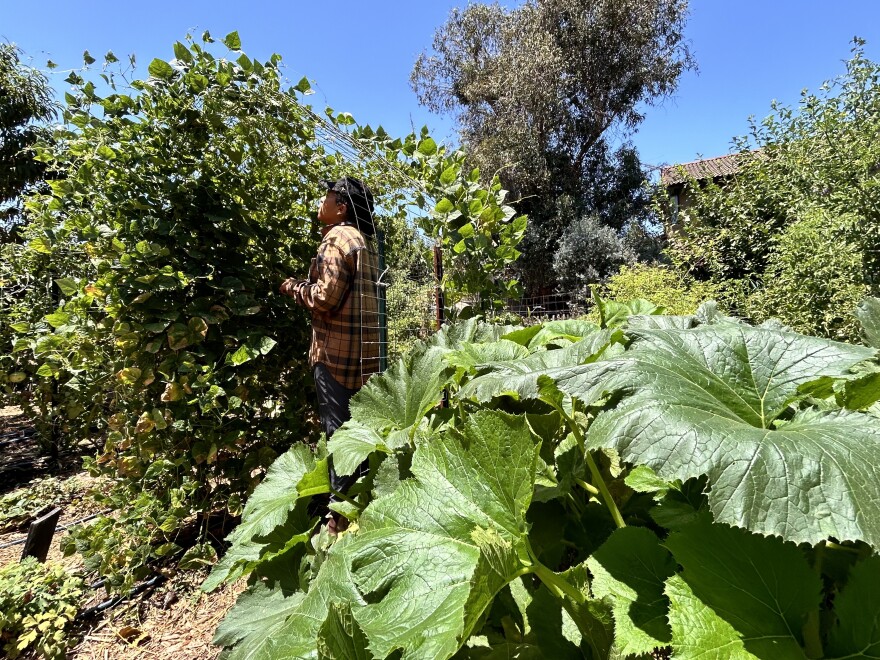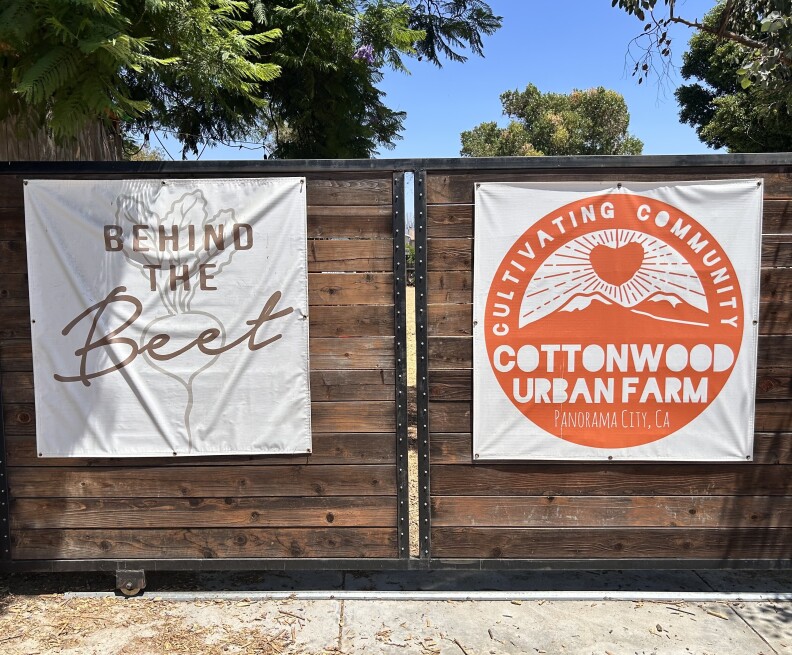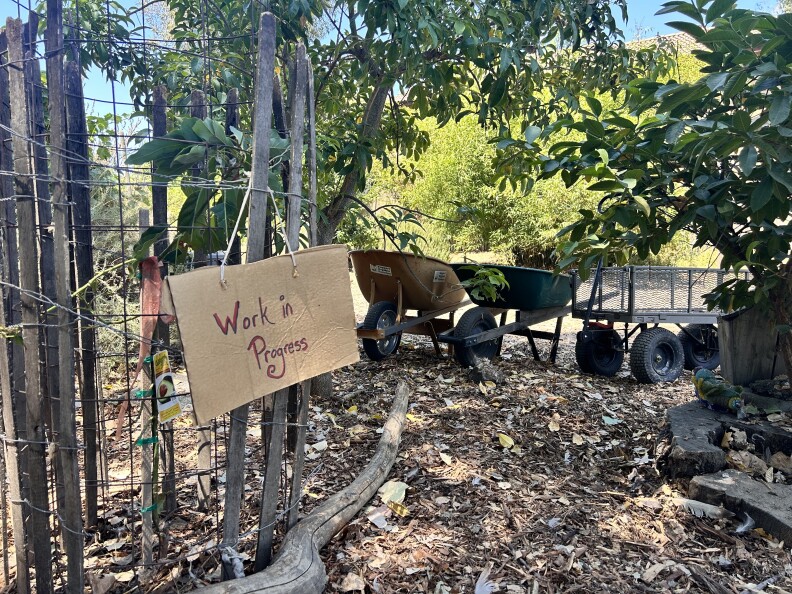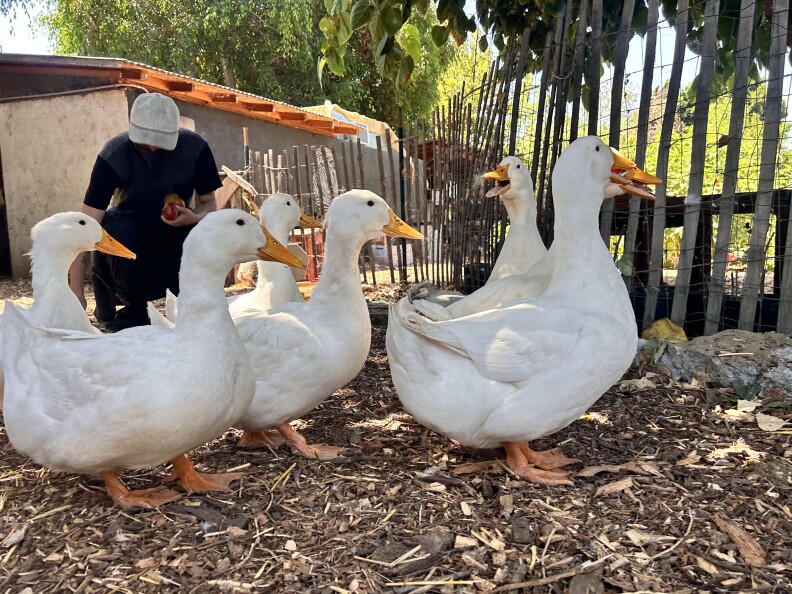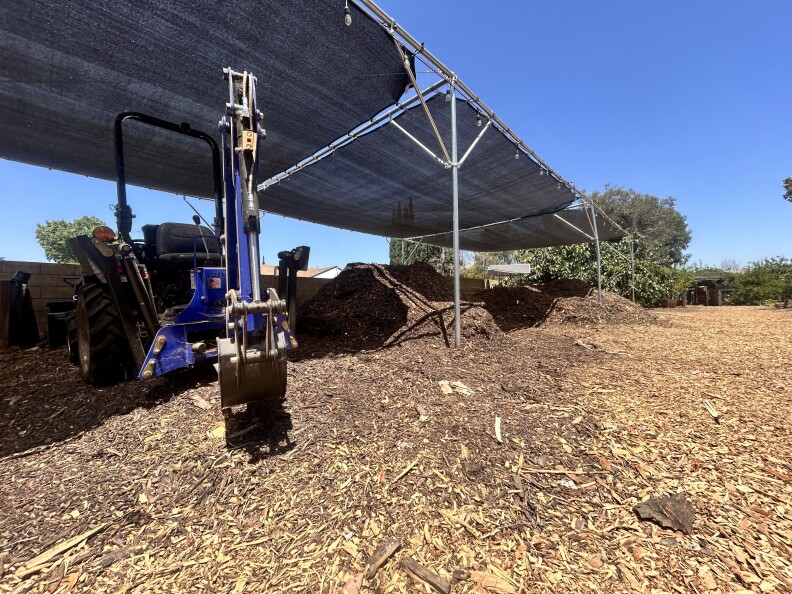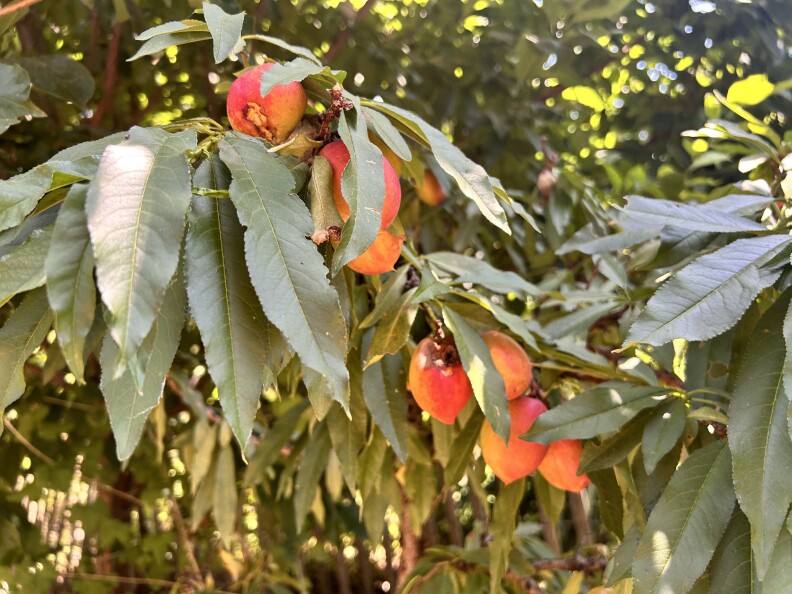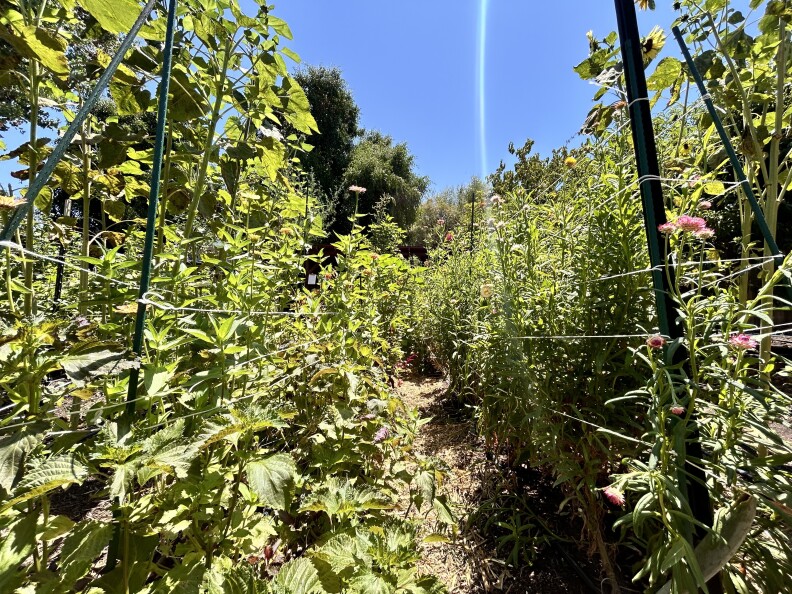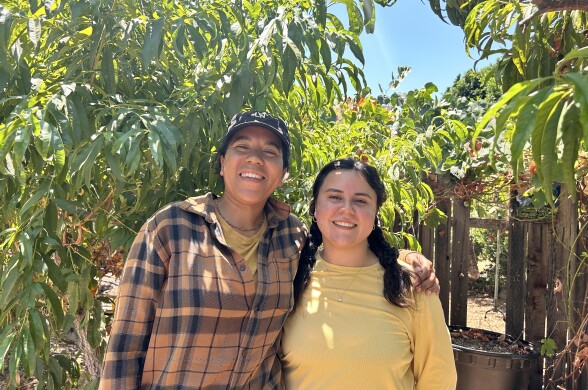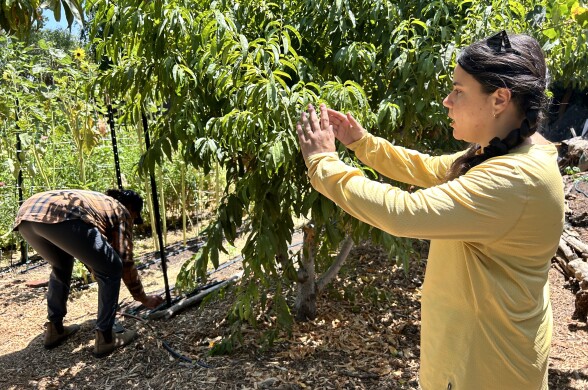-
Climate change is affecting our food, and our food is affecting the climate. LAist, together with NPR is dedicating a week to stories and conversations about the search for solutions.
The San Fernando Valley is a quintessential Los Angeles suburb.
But now that climate change has made the valley's classic clean-cut lawns more unsustainable, some people have been replacing their green grass with crops.
So could this slice of suburbia, with more than 1.8 million people living across 260 square miles, be home to the next farming revolution?
Elliott Kuhn, owner of Cottonwood Urban Farm in the San Fernando Valley, told LAist you might not make a living selling boutique microgreens from your front lawn, but it absolutely can work on a smaller scale to help feed your family and build a community with your neighbors.
“I think the opportunity here for L.A. specifically … is the idea that we have one of the largest stages in the world,” Kuhn said. “If we can lay out a pathway that's replicable here for transforming underutilized space to valuable green space that can be used and important to people, holy smokes, man. Holy smokes.”
Turning vacant land into a community farm
The Cottonwood Urban Farm sits on a half acre of land right off Roscoe Boulevard, near the border of Panorama City and Arleta.
It used to be an empty lot that looked like the pavement landscape around it, but Kuhn said it’s become a “collective organism” of nonprofit organizations, for-profit companies, and government entities since he took over 13 years ago.
“It's really just community creation and building,” he said. “And leveraging agriculture and horticulture as the vehicle.”
Cottonwood Urban Farm, named after the century-old cottonwood tree that casts much-needed shade over parts of the property, grows stone fruit, figs, bananas, white sapotes, and Pakistan mulberries, to name a few.
People in the neighborhood are welcome to drop off food waste or wood chips at the front gate for free through LA Compost, an organization that shares some of the space, which is then used for the farm’s ground and garden beds.
There are mounds of mulch, about a dozen birds keeping the beetles in check, and a trio of beehives that help pollinate the plants. Kuhn said the food and waste that is generated in the San Fernando Valley is finding its way back into the soil in the same general area.
“I feel like, at least for me, urban farming is sharing the story and trying to activate people to learn about the systems and maybe grow stuff themselves,” he said. “I think the opportunity for ‘suburban farming’ is to build community, show connection.”
The logistics
There are several challenges associated with converting a yard into a suburban farm in the San Fernando Valley, including water.
How much people pay depends on their water rate, and the Los Angeles Department of Water and Power has specific guidelines for what qualifies for the agricultural rate, including use and acreage. Many urban farms haven’t been able to meet that rate, Kuhn noted.
Haven Kiers, an associate professor in landscape architecture at UC Davis who primarily focuses on small-scale suburban designs, agreed that water is a factor — especially in the West. She told LAist that lawns are a “waste” in this way, and the benefits of having your own vegetation far outweigh the initial costs.
“You're really going to be sensing when do these trees need it, how much do they need, so that it's not like that crazy waste of water,” Kiers said. “And, you know, there is something to be said, too, about using water that is going to help cool that surrounding environment, and also help cool areas within the house, and so you're not going to necessarily need to use air conditioning as much.”
Plus, if you’re producing flowers and food locally, Kiers said, you’re helping cut down on transportation emissions. And growing crops in the space and seasons you do have, rather than a year-round greenhouse, can reduce the amount of energy and fertilizers being used, she noted.
A space for everyone
Transforming and maintaining a front yard farm can seem incredibly daunting to some, but Kiers said it’s become an opportunity for capitalism, community, and companies to step-in, especially as “urban farming is so hot right now.”
“There's definitely, definitely a market for it, definitely a space for anyone to come in with that knowledge to design, install, and maintain these front yard gardens as urban farms,” she said.
And Urban Farms LA has been doing exactly that since 2012.
What's really cool to me about gardening and urban farming is the way that we can use produce for ourselves to also rewild and heal our cities, and reduce the carbon footprint of traditional agricultural farming. It is truly astounding how much food you can grow on what used to be a front lawn.
Sophie Pennes, founder and owner, told LAist the organization specializes in California native landscaping and edible vegetable gardens, with clients including an urban farm near LAX and more than 40 residential gardens.
“We can grow potatoes, onions, you know, broccoli, tomatoes, melons, squash, everything,” she said, including about 130 pounds of onions from a 210-square-foot space.
Early in her career, Pennes used to have to convince people to get rid of their lawns, but now she said business is booming. Urban Farms LA’s four-person team visits some clients a couple times a year, while others every few weeks.
“What's really cool to me about gardening and urban farming is the way that we can use produce for ourselves to also rewild and heal our cities, and reduce the carbon footprint of traditional agricultural farming,” she said. “It is truly astounding how much food you can grow on what used to be a front lawn.”
-
- Don’t be afraid to start small, it doesn’t have to be all or nothing.
- A few raised beds of tomatoes won’t take up that much lawn and is something you could put together yourself.
- Don’t be afraid to start small, it doesn’t have to be all or nothing.
-
- Don’t worry if you don’t have that much space. Use the land you do have, a little can go a long way.
-
- If it all seems a bit overwhelming, look for companies like Urban Farms LA, which can help you design and maintain your front yard farm or residential garden.
Taking the next steps
Thy Chau, who lives a few blocks away from the farms in Panorama City, sells organic jujubes, also known as Chinese dates, at three different farmer’s markets around the city.
She told LAist she has more than 30 trees in her yard at this point, but it all started as a way to thank the doctors and nurses caring for her mother, hence the word “mom” in the middle of her jujube logo.

She soon had more fruits than she knew what to do with, so she processes, dehydrates, and turns them into products, including 16-ounce juices that go for $5, and dried jujubes for $7 each half pound.
“[My family] say that’s too hard for you, why you have to do all of this,” Chau said. “I say because we have good food. I just like to share with people.”
Black Thumb Farm, which offers hands-on programs for young people in farming and gardening, also works out of the Cottonwood space.
In July — which was also the hottest on record across California, according to the National Centers for Environmental Information — they were able to harvest 256 pounds of food, more than 1,300 flower stems, and divert 246 pounds of green waste to the LA Compost site up front, according to Alexys Romo, the organization’s executive director and farm hands coordinator.
-
- If you want to put your food scraps to good use, you can connect with LA Compost for their farmers market drop-offs and volunteer opportunities, or leave it at Cottonwood Urban Farm any time of day.
-
- And if you or your children want to visit a San Fernando Valley urban farm, Black Thumb Farm offers field trips, group volunteer days, and educational workshops.
Romo noted they could scale up to produce even more, but they’re focused on teaching others how to experiment and grow food. That means there've been some casualties along the way, such as this past summer when they turned half of the farm into flowers, or when they tried to grow mushrooms for three months.
“Everybody doesn't need to do everything,” she said. “When you're in an urban setting, that's not necessary. It's great for you to be a jack of many trades, but there's also a lot of jacks around here.”
LAist takes the climate emergency seriously. And our coverage is unique because we took the time to listen to Southern Californians about their concerns. With more climate coverage than ever before, we are here for you every single day with stories that provide actionable information so you can make your everyday life better.
But we cannot do this essential work without your help. We rely on donations from readers like you to stay independent, which keeps our nonprofit newsroom strong and accountable to you.
At a time when the need for local journalism has never been greater, many newsrooms are facing cutbacks, including LAist. Member support – your support – is what will sustain a free press in Southern California.
LAist’s mission is to be here for you, so please be here for us now with a donation to power our trusted local reporting. Step up right now and make the choice to give. Because that’s exactly what it is - a choice. But it is not a choice without consequences. If readers do not choose to step up and donate, the future of fact-based news in Southern California will not be as strong.
No matter what happens in the world, LAist will remain a voice you know and trust.
Thank you for your generous support.
Sincerely,
-
(she/her)



